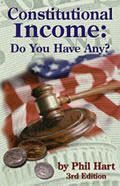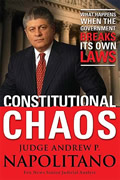Other
Collins
Articles:
Darwinism and the Rise of Gnosticism
Engineering Evolution: The Alchemy of Eugenics
CULTIVATING
CRIMINALITY
PART 1 of 2
Phillip
D. Collins
March 24, 2006
NewsWithViews.com
Desirable Criminality?
On the February 13, 2006 edition of MSNBC�s Live and Direct, Rita Cosby examined the growing street gang known as La Mara Salvatrucha or MS-13 (no pagination). This criminal enterprise is transnational in scope, stretching from �El Salvador to Honduras to Guatemala to New Mexico, and now on U.S. soil� (no pagination). Infamous for their exceptionally violent methods, MS-13 has ascended to a prominent position in the criminal underworld. Rita Cosby elaborates:
The majority of MS-13 members are foreign-born and are frequently involved in human and drug smuggling and immigration violations. Like most street gangs, MS-13 members are also committed to such crimes as robbery, extortion, rape and murder. They also run a well-financed prostitution ring.
This notorious gang, best known for their violent methods, can now be found in 33 states, with an estimated 10,000 members and more than 40,000 in Central America. The FBI says MS-13 are the fastest growing and most violent of the nation's street gangs. So much so, even other gangs fear them. (No pagination)
The gang�s membership also boasts a vicious array of skills:
What makes MS-13 so deadly is their skill with the machete, and most have had extensive military training in El Salvador, making them a double threat. The machete, typically used for cutting crops in El Salvador, is now the weapon of choice for this fearless gang. (No pagination)
Clearly, MS-13 is more than the average gang of thugs and miscreants. It is literally a terrorist network, peopled by skilled warriors and equipped with a paramilitary auxiliary. MS-13�s growth and development is hardly some inexplicable social phenomena. Reader�s Digest writer Sam Dealy reveals the chief facilitator of MS-13�s ascendance: �This is a problem that the federal government actually created� (no pagination). This is a very interesting claim. Just how did the United States create this burgeoning gang crisis? Dealy explains:
Our default policy throughout much of the past decade has been simply to, when you catch these guys, deport them. And they head back to Guatemala, or El Salvador, or Honduras, and weak states back there can't control them. (No pagination)
MS-13 is a threat fostered by America�s own impotent immigration policies. No doubt, many categorize this situation as an instance of bureaucratic ineptitude. In a world ruled by the accidentalist perspective of history, this is a common explanation.
However, it does not account for the factors that weakened America�s border integrity in the first place. In this era of globalization, the public has been bombarded by talk of enacting open border policies. Many of those voicing this contention occupy lofty positions in the Establishment. It comes as little surprise that members of the ruling class would endorse such policies. Vanishing borders are a correlative of vanishing national sovereignty. This gradual subversion of the nation-state system is integral to the power elite�s plan to establish a socialist totalitarian world government. Yet, the criminal culture resulting from this plan is hardly some unintended byproduct. MS-13 and other criminal enterprises produced by globalization are integral to the statist blueprint of a global scientific dictatorship.
The Function of Deviance
Paradoxical though it may seem, deviance provides the power elite with an element of stability. This contention is premised upon the functionalist theories of sociologist Emile Durkheim. Durkheim believed that �deviance is not only normal but also beneficial to society because, ironically, it contributes to social order� (Thio 157).
According to Durkheim, deviance serves four important functions. The first of these four functions is the enhancement of conformity (157). This function is premised upon the paradoxical notion that otherwise abstract concepts of criminal law can only be illustrated by their violation. Durkheim contends that, by committing crimes, the deviant tangibly enacts principles that are antithetical to the law. In so doing, the deviant supposedly makes the law �real.� Once incarcerated and properly punished, the deviant is sacrificed on the altar of conformity for the education of the public. Because the letter of the law must be consistently reiterated for the common citizen, society requires an inexhaustible supply of deviants to act as examples.
The second function served by the deviant is the reinforcement of solidarity among �law-abiding� individuals (157). The deviant �promotes social cohesion� (157). The �collective outrage� generated by criminals unifies the citizenry and facilitates the stability of society (157). Thus, deviance, in the words of Durkheim, constitutes �a factor in public health, an integral part of all healthy societies� (qutd. in 157). In other words, society requires an enemy. The so-called �solidarity� induced by deviance is a solidarity of fear and paranoia, not of common dissent. There is no better example of this contention than the nationalistic fervor following the September 11th attacks. Bin Laden became the proverbial boogey man, a chimera invoked by the power elite to justify the erection of a garrison state. In this sense, deviance is analogous to Orwell�s �Two Minutes Hate.� It is an instrument for demonizing a nebulous adversary and apotheosizing the cult of personality.
The third function of deviance is the provision of a �safety valve� (157). Crime is a necessary cathartic exercise, allowing people to avenge themselves against the dominant social order (157). Fragmented deviance is a viable alternative to civil unrest.
From the perspective of the power elite, individual criminal acts are far more desirable than movements unified by common dissent. Although deviance does induce a certain degree of so-called �solidarity,� the resulting unity is one born of fear and paranoia. This unity should not be confused with genuine grass roots mobilization, which is born of legitimate social and/or political dissension. Criminality effectively atomizes society, stultifying grass roots opposition to the oligarchs. The rationale underpinning this third function inverts the classic mantra, �United we stand, divided we fall.� Division becomes central to societal stability. Deviance, which fractures the social body by promulgating fear and paranoia among its members, becomes an agent of stability.
The fourth and most significant function of deviance is its role in the inducement of social change (157). Through shock and trauma, crime makes populations more tractable. Again, September 11th stands as a prime example. The WTC attacks provided the pretext for the introduction of the draconian Patriot Act. Traumatized as the population was, the post-911 cultural milieu began to entertain the legitimacy of omnipotent surveillance programs. America has come under the �normalizing gaze� of panoptic mechanisms like Echelon, Carnivore, and the Promis surveillance software. Public acquiescence to such authoritarian measures was made possible, in large part, by the perpetuation of deviance.
|
Subscribe to the NewsWithViews Daily News Alerts! |
Durkheim�s functionalist perspective on deviance seems to significantly influence the American legal system, a contention reinforced by the revolving doors of criminal justice. Murderers and rapists serve shorter sentences than non-violent drug offenders. They are subsequently unleashed back upon society. Members of radical organizations like MS-13 are temporarily incarcerated and deported. The same individuals eventually return to the United States with more initiates, drugs, and guns. Evidently, a cyclical pattern is taking shape. For part 2 click below.
Click here for part -----> 2
Sources Cited
1,
Baigent, Michael, Richard Leigh, and Henry Lincoln. Holy Blood, Holy
Grail. New York: Delacorte, 1982.
2, Bannister, Robert. Sociology and Scientism. London: North
Carolina UP, 1987.
3, Billington, James H. Fire in the Minds of Men: Origins of
the Revolutionary Faith. New York: Basic, 1980.
4, Cosby, Rita. "'MS-13'
is one of nation's most dangerous gangs." MSNBC 13 February 2006
5, Fischer, Frank. Technocracy and the Politics of Expertise.
Newbury Park, California: Sage Publications, 1990.
6, Foucault, Michel. Discipline and Punish: The Birth of the
Prison. Trans. Alan Sheridan. New York: Pantheon, 1977.
7, Hoffman, David. The
Oklahoma City Bombing and the Politics of Terror. 1998. The Constitution
Society.
8, Howard, Michael. The Occult Conspiracy: Secret Societies-Their
Influence and Power in World History. Vermont: Destiny Books, 1989.
9, Keith, Jim. Casebook on Alternative Three. Lilburn, GA:
Illuminet Press, 1994.
10, Taylor, Ian T. In the Minds of Men: Darwin and the New
World Order. Toronto: TFE Publishing, 1999.
11, Thio, Alex. Sociology: A Brief Introduction. 2000. New
York: Pearson Education, 2005.
� 2006 Phillip D. Collins
- All Rights Reserved
Author Phillip D. Collins acted as the editor for The Hidden Face of Terrorism. He has also written articles for Paranoia Magazine, MKzine, NewsWithViews.com, and B.I.P.E.D.: The Official Website of Darwinian Dissent and Conspiracy Archive. He has an Associate of Arts and Science.
Currently, he is studying for a bachelor's degree in Communications at Wright State University. During the course of his seven-year college career, Phillip has studied philosophy, religion, and classic literature. He also co-authored the book, The Ascendancy of the Scientific Dictatorship: An Examination of Epistemic Autocracy, From the 19th to the 21st Century, which is available at: [Link]
E-Mail: collins.58@wright.edu
The WTC attacks provided the pretext for the introduction of the draconian Patriot Act. Traumatized as the population was, the post-911 cultural milieu began to entertain the legitimacy of omnipotent surveillance programs.












